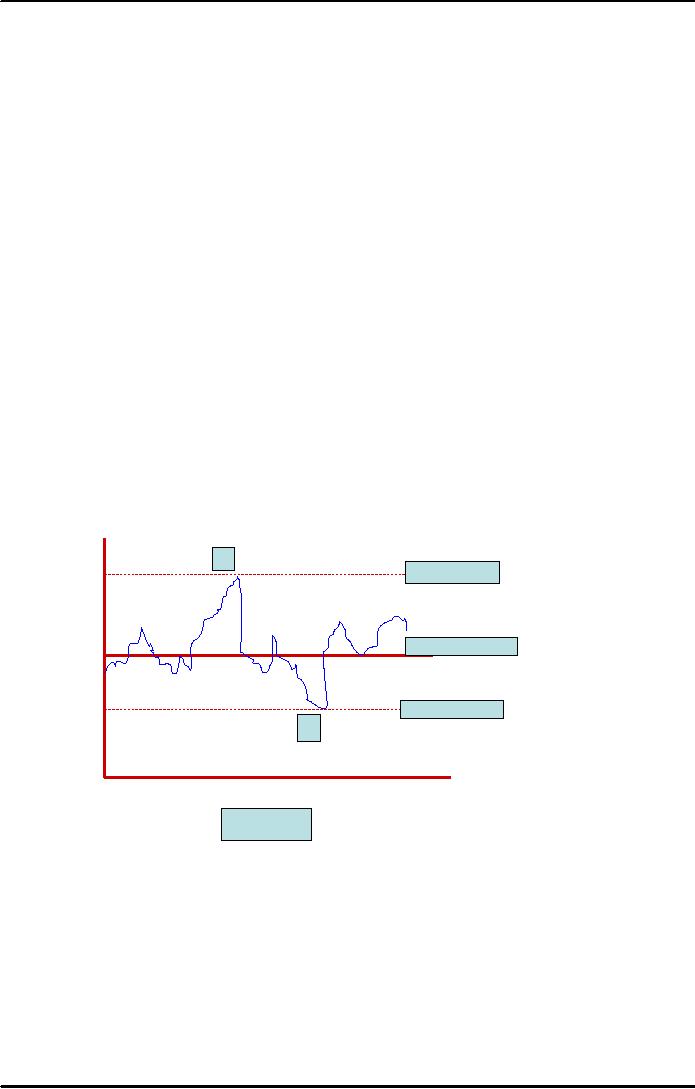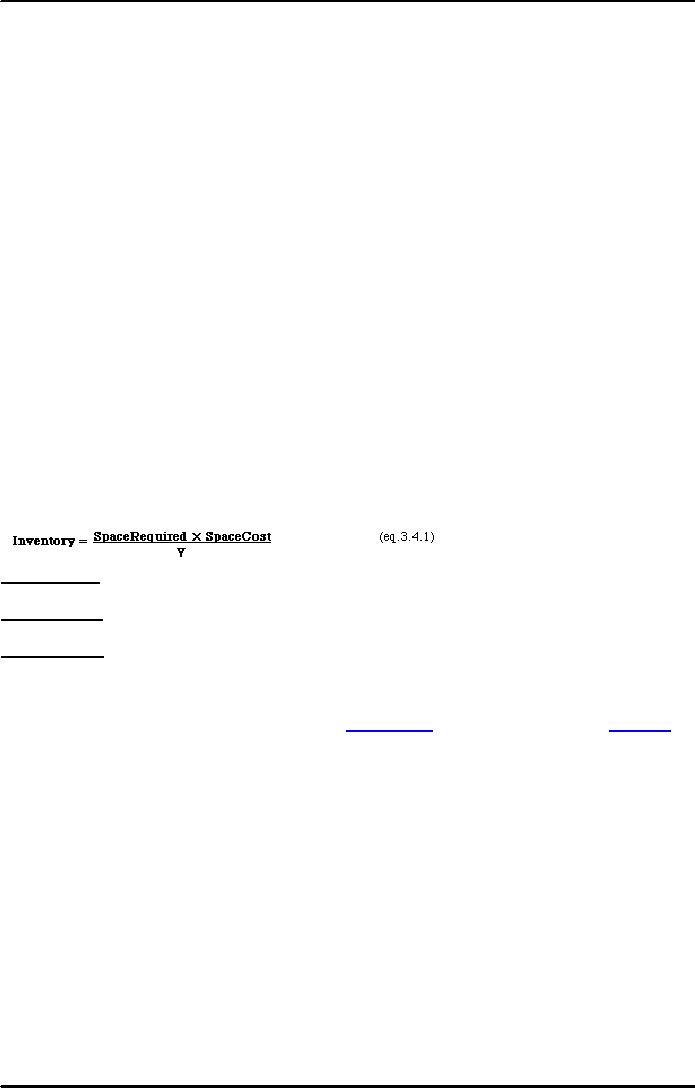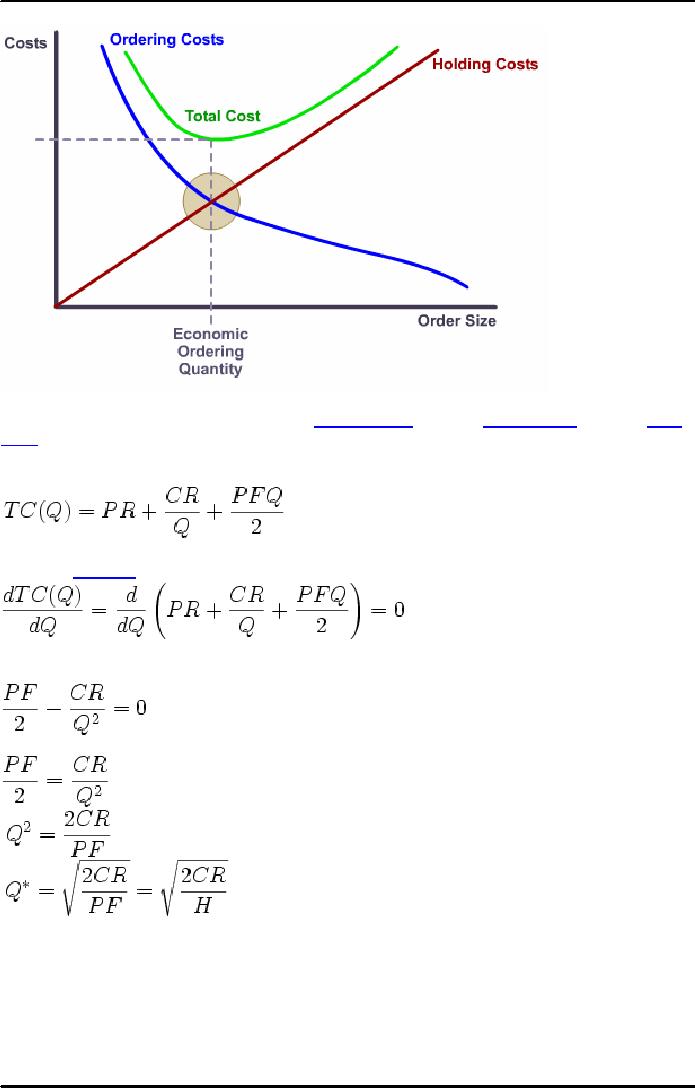 |

Corporate
Finance FIN 622
VU
Lesson
29
INVENTORY
MANAGEMENT
The
following topics will be
discussed in this lecture.
Miller-Orr
Model of cash
management
Inventory
management
Inventory
costs
Economic
order quantity
Reorder
level
Discounts
and EOQ
Miller-Orr
Model for Cash
Management:
Most
firms maintain a minimum amount of cash on hand to
meet daily obligations or as a requirement
from
the firm's bank. A
maximum amount may also be
specified to reflect the tradeoff between
the transaction
cost
of investing in liquid assets (e.g.
Money Market Funds) and the
cost of lost interest if the cash is
not
invested.
The Miller-Orr model computes the
spread between the minimum
and maximum cash
balance
limits
as
Spread
=
3(0.75 x transaction cost x
variance of daily cash flows / daily
interest rate) ^(1/3)
(where
a^b is used to denote "a to the power
b").
The
maximum cash balance is the
spread plus the minimum cash
balance, which is assumed to be
known.
The
"return
point" is
defined as the minimum cash
balance plus spread/3.
Whenever
the cash balance hits (or
exceeds) the maximum, the firm should
invest the difference between
the amount
available and the return
point; if the minimum is reached,
sufficient securities should be sold
to
bring
it up to the return point.
� MILLER-ORR
MODEL:
A
CASH
UPPER
LIMIT
RETURN
POINT
LOWER
LIMIT
B
TIME
Graph
Explanation:
When
cash balance reaches point
`A', the upper limit, company
will invest the surplus to bring
down the
cash
balance to return
point.
When
cash balance touches down
point `B', the lower limit,
the company would liquidate
some of its
securities
to increase the balance back to
return point.
Upper
and lower limits are
determined as explained above.
These
limits depend upon variance
of cash flow, transaction
cost and interest
rate.
If
variability of cash flow is
high and transaction cost is
high too, then the limits
will be wide apart,
otherwise
narrow would suffice.
If
interest rates are high
then the narrow limits would be
set.
96

Corporate
Finance FIN 622
VU
To
keep interest cost as low as
possible, the return point is
set 1/3 of the spread
between the lower and
upper
limit.
Inventory
Management:
Inventory
management is the active control program
which allows the management of
sales, purchases
and
payments.
Inventory
management software helps
create invoices, purchase
orders, receiving lists,
payment receipts
and
can print bar coded
labels. An inventory management
software system configured to
your warehouse,
retail or
product line will help to
create revenue for your
company. The Inventory
Management will
control
operating costs and provide better
understanding. We are your
source for inventory
management
information,
inventory management software
and tools.
A
complete Inventory Management
Control system contains the
following components:
� Inventory
Management Definition
� Inventory
Management Terms
� Inventory
Management Purposes
� Definition
and Objectives for Inventory
Management
� Organizational
Hierarchy of Inventory
Management
� Inventory
Management Planning
� Inventory
Management Controls for
Inventory
� Determining
Inventory Management Stock
Levels
�
1. Inventory
costs
Inventory
costs depend on the amount of space
required, and how much that
space costs. If the
assumption
is
made that every part
spends an equal amount of time
located in inventory, then the
cost of inventory can
be
shared equally amongst all
parts. This simplification leads to
equation 3.4.1 as an expression for
the
inventory
costs:
Carrying
cost:
Cost
of holding an item in inventory.
Ordering
cost:
Cost
of replenishing inventory
Shortage
Cost:
Temporary or
permanent loss of sales when
demand customers don't find
the product in the market
and
switch
over to substitute
products.
2.
Economic order
quantity
EOQ
The
amount of orders that minimizes
total variable
costs required to
order and hold inventory.
Re-order
quantity is the quantity for
which order is placed when the
stock reached re-orders level. By
fixing
this
quantity the purchaser has
not to be to re-calculate the quantity to
be purchased each time he orders
for
material.
Re-order
quantity is known as economic
order quantity because it is the
quantity which is most
economical
to order. In
other words, economic order
quantity is that size of
quantity of the order which
gives
maximum
economy in purchasing any
material and ultimately contributes
towards maintaining the material
at the
optimum level and minimum
cost.
While
setting economic order
quantity, two types of cost
should be taken into
account:
1. Ordering
Cost: This
is the cost of placing an order
with the supplier. Because of so many
factors
involved,
it is quite difficult to quantify this
cost. It mainly includes the cost of
stationary, salaries of
those
engaged in receiving and inspection,
salaries of those engaged in
placing an order, etc.
2. Cost
of Carrying Stock: This
is the cost of holding the stock in
storage.
It
includes the following:
(a)
cost of operating the stores,(salaries, rent,
stationary)
(b) the
incidence of insurance
cost;
(c)
interest on the capital locked up in
store;
(d)
Deterioration and wastage of
material.
97

Corporate
Finance FIN 622
VU
A
graph illustrating the relationship
amongst the Ordering
Costs curve,
the Holding
Costs curve,
the Total
Costs
curve
and the Economic ordering
quantity
The
single item EOQ formula can
be seen as the minimum point of the
following cost
function:
Total
cost = purchase cost + order
cost + holding cost, which
corresponds to:
.
Taking
the derivative
of
both sides of the equation and
setting equal to zero, one
obtains
.
The
result of this differentiation
is:
Solving
for Q:
.
3.
Reorder level
This
is that level of material at which
purchase requisition is initiated
for fresh supplies. This is
fixed some
where
between minimum level and
maximum level. This is fixed in
such a way that by re-ordering
when
material
falls to this level, then in the normal
course of events, new
supplies will be received
just before the
minimum
level is reached. Its formula
is:
Re-order
Level = Maximum consumption * Maximum
re-order period
The
following factors are
considered in fixing this level:
98

Corporate
Finance FIN 622
VU
1.
Rate of consumption of the
material
2.
Minimum level
3.
Delivery time; i.e., the time normally
taken from the time of initiating a
purchase requisition, to the
receipts
of material
4.
Variation in delivery time.
4. Discounts
and EOQ
Discounts
are reductions
to a basic price.
They could modify either the manufacturer's
list price
(determined by the
manufacturer and often
printed on the package), the retail price
(set by the retailer and
often
attached to the product
with a
sticker), or the list price (which is
quoted to a potential buyer, usually
in
written
form). The market price
(also called effective price) is the
amount actually paid. The purpose
of
discounts
is to increase short-term sales, move
out-of-date stock, reward
valuable customers, or
encourage
distribution
channel members
to perform a function. Some
discounts and allowances are
forms of sales
promotion.
EOQ
The
amount of orders that minimizes
total variable
costs required to
order and hold inventory.
Re-order
quantity is the quantity for
which order is placed when the
stock reached re-orders level. By
fixing
this
quantity the purchaser has
not to be to re-calculate the quantity to
be purchased each time he orders
for
material.
99
Table of Contents:
- INTRODUCTION TO SUBJECT
- COMPARISON OF FINANCIAL STATEMENTS
- TIME VALUE OF MONEY
- Discounted Cash Flow, Effective Annual Interest Bond Valuation - introduction
- Features of Bond, Coupon Interest, Face value, Coupon rate, Duration or maturity date
- TERM STRUCTURE OF INTEREST RATES
- COMMON STOCK VALUATION
- Capital Budgeting Definition and Process
- METHODS OF PROJECT EVALUATIONS, Net present value, Weighted Average Cost of Capital
- METHODS OF PROJECT EVALUATIONS 2
- METHODS OF PROJECT EVALUATIONS 3
- ADVANCE EVALUATION METHODS: Sensitivity analysis, Profitability analysis, Break even accounting, Break even - economic
- Economic Break Even, Operating Leverage, Capital Rationing, Hard & Soft Rationing, Single & Multi Period Rationing
- Single period, Multi-period capital rationing, Linear programming
- Risk and Uncertainty, Measuring risk, Variability of return–Historical Return, Variance of return, Standard Deviation
- Portfolio and Diversification, Portfolio and Variance, Risk–Systematic & Unsystematic, Beta – Measure of systematic risk, Aggressive & defensive stocks
- Security Market Line, Capital Asset Pricing Model – CAPM Calculating Over, Under valued stocks
- Cost of Capital & Capital Structure, Components of Capital, Cost of Equity, Estimating g or growth rate, Dividend growth model, Cost of Debt, Bonds, Cost of Preferred Stocks
- Venture Capital, Cost of Debt & Bond, Weighted average cost of debt, Tax and cost of debt, Cost of Loans & Leases, Overall cost of capital – WACC, WACC & Capital Budgeting
- When to use WACC, Pure Play, Capital Structure and Financial Leverage
- Home made leverage, Modigliani & Miller Model, How WACC remains constant, Business & Financial Risk, M & M model with taxes
- Problems associated with high gearing, Bankruptcy costs, Optimal capital structure, Dividend policy
- Dividend and value of firm, Dividend relevance, Residual dividend policy, Financial planning process and control
- Budgeting process, Purpose, functions of budgets, Cash budgets–Preparation & interpretation
- Cash flow statement Direct method Indirect method, Working capital management, Cash and operating cycle
- Working capital management, Risk, Profitability and Liquidity - Working capital policies, Conservative, Aggressive, Moderate
- Classification of working capital, Current Assets Financing – Hedging approach, Short term Vs long term financing
- Overtrading – Indications & remedies, Cash management, Motives for Cash holding, Cash flow problems and remedies, Investing surplus cash
- Miller-Orr Model of cash management, Inventory management, Inventory costs, Economic order quantity, Reorder level, Discounts and EOQ
- Inventory cost – Stock out cost, Economic Order Point, Just in time (JIT), Debtors Management, Credit Control Policy
- Cash discounts, Cost of discount, Shortening average collection period, Credit instrument, Analyzing credit policy, Revenue effect, Cost effect, Cost of debt o Probability of default
- Effects of discounts–Not effecting volume, Extension of credit, Factoring, Management of creditors, Mergers & Acquisitions
- Synergies, Types of mergers, Why mergers fail, Merger process, Acquisition consideration
- Acquisition Consideration, Valuation of shares
- Assets Based Share Valuations, Hybrid Valuation methods, Procedure for public, private takeover
- Corporate Restructuring, Divestment, Purpose of divestment, Buyouts, Types of buyouts, Financial distress
- Sources of financial distress, Effects of financial distress, Reorganization
- Currency Risks, Transaction exposure, Translation exposure, Economic exposure
- Future payment situation – hedging, Currency futures – features, CF – future payment in FCY
- CF–future receipt in FCY, Forward contract vs. currency futures, Interest rate risk, Hedging against interest rate, Forward rate agreements, Decision rule
- Interest rate future, Prices in futures, Hedging–short term interest rate (STIR), Scenario–Borrowing in ST and risk of rising interest, Scenario–deposit and risk of lowering interest rates on deposits, Options and Swaps, Features of opti
- FOREIGN EXCHANGE MARKET’S OPTIONS
- Calculating financial benefit–Interest rate Option, Interest rate caps and floor, Swaps, Interest rate swaps, Currency swaps
- Exchange rate determination, Purchasing power parity theory, PPP model, International fisher effect, Exchange rate system, Fixed, Floating
- FOREIGN INVESTMENT: Motives, International operations, Export, Branch, Subsidiary, Joint venture, Licensing agreements, Political risk